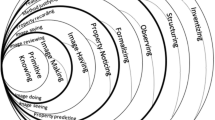Overview
- Authors:
-
-
Gerry Stahl
-
The iSchool & the Math Forum, Drexel University, USA
Access this book
Other ways to access
About this book
Translating Euclid reports on an effort to transform geometry for students from a stylus-and-clay-tablet corpus of historical theorems to a stimulating computer-supported collaborative-learning inquiry experience. The origin of geometry was a turning point in the pre-history of informatics, literacy, and rational thought. Yet, this triumph of human intellect became ossified through historic layers of systematization, beginning with Euclid’s organization of the Elements of geometry. Often taught by memorization of procedures, theorems, and proofs, geometry in schooling rarely conveys its underlying intellectual excitement. The recent development of dynamic-geometry software offers an opportunity to translate the study of geometry into a contemporary vernacular. However, this involves transformations along multiple dimensions of the conceptual and practical context of learning. Translating Euclid steps through the multiple challenges involved in redesigning geometry education to take advantage of computer support. Networked computers portend an interactive approach to exploring dynamic geometry as well as broadened prospects for collaboration. The proposed conception of geometry emphasizes the central role of the construction of dependencies as a design activity, integrating human creation and mathematical discovery to form a human-centered approach to mathematics. This book chronicles an iterative effort to adapt technology, theory, pedagogy and practice to support this vision of collaborative dynamic geometry and to evolve the approach through on-going cycles of trial with students and refinement of resources. It thereby provides a case study of a design-based research effort in computer-supported collaborative learning from a human-centered informatics perspective.
Similar content being viewed by others
Table of contents (11 chapters)
-
Front Matter
Pages i-xxii
-
-
-
-
-
-
-
-
-
-
-
-
Back Matter
Pages 201-221
Authors and Affiliations
-
The iSchool & the Math Forum, Drexel University, USA
Gerry Stahl
About the author
My life began when I first encountered geometry in high school. From that moment on, I devoured books on mathematics, physics, and cosmology. I wondered, like Pythagoras, about the place of mathematical objects in the universe. This led me (via the logicians) to philosophy. I could not wait to explore these topics as an undergrad at MIT. Once there, however, I became discouraged about the contemporary approach to math and physics education, as well as the militaristic uses being made of them. I turned increasingly to philosophy, moving away from positivism to its critique by 20th century continental thought. Upon graduation, I went to Heidelberg for a year to study German philosophy during the exhilarating 1960s, later spending two years at the Frankfurt School. Meanwhile, I completed a doctoral dissertation on Marx and Heidegger at Northwestern. Back in Philadelphia, I briefly tried my hand at teaching remedial high school math at an urban public school. However, I soon found systemsprogramming to be a less frustrating way to earn a living. I also engaged in union and community organizing, learning how to bring federal grants into the neighborhoods for local development. When the first personal computers appeared, I ran a service to help non-profit organizations computerize. Eventually, I decided to fill in my computer science background at the University of Colorado in Boulder, where I earned a doctorate in artificial intelligence and cognitive science. My research work after graduation is documented in Group Cognition (MIT Press, 2006). Following a year abroad at a CSCW lab outside Bonn, I went to the College of Information Science at Drexel to teach HCI and CSCL in 2002. In collaboration with many colleagues, I started the VMT Project, which is reported on in Studying Virtual Math Teams (Springer, 2009). My specialty is Computer-Supported Collaborative Learning. I founded the International Journal of CSCL and have been active in the CSCL Conference series. My most recent ideas, discoveries, and wonderings are brought together in Translating Euclid.




